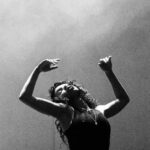Create A Personal Bubble:DMT’s Initial Exploration

Summary
This open-ended toolkit is designed to help learners find their inner energy by feeling their body move, guiding them to connect with their body and mind to feel their own healing. You don't need to have any dance or movement experience, just a passion to try to dive into your body, feel the intuitive whispers of your body's movement, and listen to it patiently so it can begin to heal at its own pace with ease and freedom. We believe that trauma is stored within the body and that self-healing can be achieved by simply gaining a deeper insight into our own body and how it works.
The freest body holds the richest wisdom.
This open toolkit leads learners on a first exploration and experience of Dance/Movement Therapy. Dance/Movement Therapy (DMT) is a unique psychotherapeutic approach that promotes emotional, social, cognitive, and physical integration of the individual through physical movement. The therapy is based on the strong connection between mind and body, emphasising that changes in the body can reflect changes in mental states and vice versa. Dance therapy not only focuses on mental health issues such as anxiety, depression and post-traumatic stress disorder, but also improves physical health, muscle strength, coordination and flexibility.
♦Foundational Module(5-10min)
What is Dance/Movement Therapy(DMT) ?
-
Core Concepts:
- Mind-Body Connection: The body and mind are inseparable, and bodily movements reflect emotional and psychological states, and vice versa.
- Nonverbal Communication: Humans express emotions and subconscious thoughts through body language. Dance/movement therapy (DMT) utilizes this nonverbal form for therapeutic purposes.
- Creative Expression: Through improvisation and free movement, dance encourages emotional release and personal growth.
-
Key Theoretical Foundations:
- Laban Movement Analysis (LMA): Observing qualities, rhythm, and patterns of movement to understand psychological states.
- Mirroring Technique: Therapists replicate the client’s movements to build emotional connection and trust.
- Humanistic Psychology: Emphasizes individual potential and self-actualization, encouraging internal exploration during therapy.
If you are interested in dance movement therapy maybe you can watch this video:(optional )
Aims:
Through the dancing depiction of personal space bubbles, we hope you find peace, stability and inner energy.
If you feel lost when performing the dance, perhaps watch the following video to get a feel for how to perform the dance:(optional )
♦Practice Module(10-15min)
Follow the steps below to try and create your own bubbles.
Step 1:
Wear loose, skin-friendly clothing and choose any space that makes you relatively comfortable, such as a window where the sun shines.
Step 2:
Play your favourite light music or nature sound effects turning them up to the right volume.
If you’re not sure what kind of music to choose, don’t worry I’ve got some for you to try.
Step 3:
Adjust your breathing and try to sink into yourself. Imagine a bubble dedicated to your space within arm’s reach.
Step 4:
Attempt the following reflections through body movement.Here’s an audio to assist you with your dance movements.
Bubble(click here to listen the audio)
You don’t really have to worry about whether the dance is beautiful or not, just make sure you’re exploring!
- Dance Therapy
-What are your bubbles made of?
-What shape is your bubble?
-What colour is your bubble?
-You can slowly stretch your body to touch the edge of this bubble and how it feels
-Use your body to paint in this bubble. Your fingertips, arms, toes any body part can be used as a paintbrush.
-Let those paintings slowly fill your bubble.
-You are exchanging energy with your bubble, what do you want to release? What do you want to receive?
-Remember what this bubble looks like
-Slowly peel yourself out of this bubble and adjust your breathing
Step 5:(5min)
Remember the bubble imagery and summarize the feelings
What kind of energy exchange are you making with your bubbles as you dance?
Do you feel the energy from within your own body during the dance?
Congratulations on having created your own bubble, and I hope you’re rewarded in the process.
Create A Personal Bubble © 2 by s is licensed under CC BY-SA 4.0
(https://uk.pinterest.com/pin/376965431321927211/)



